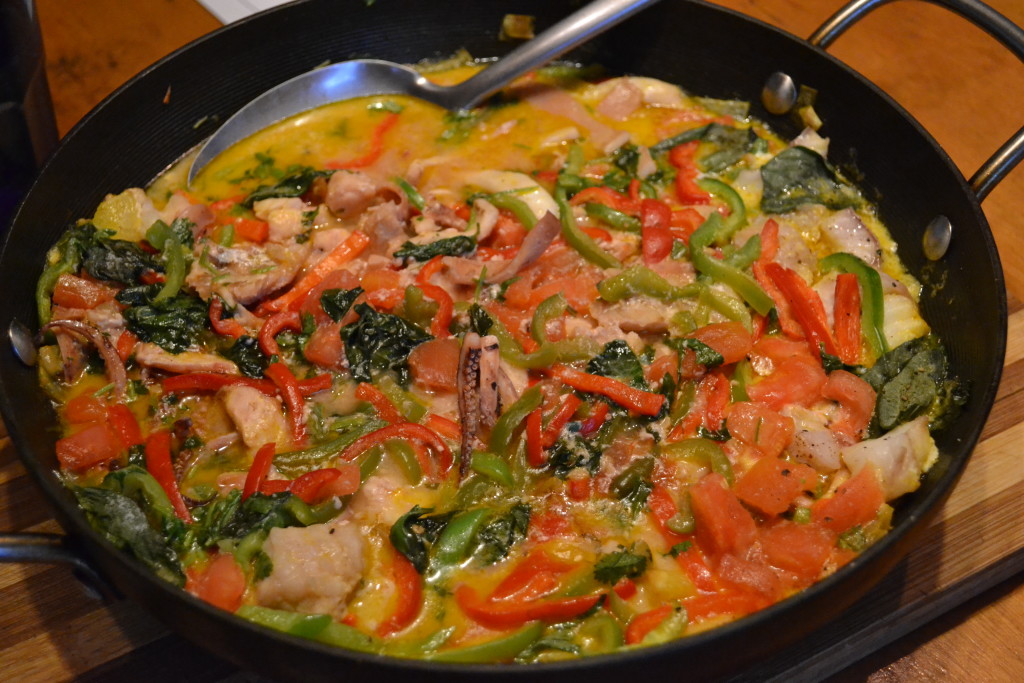On Sunday supplement
Food and Wine
From the Kimbundu language, one of two dialects of Bantu, from the country of Angola, comes the word mu’keka, meaning, more or less, a kettle of fish. Literally, not sort of hot water that one finds oneself in after getting home late from a carousing with friends. It’s a dish that some say is reminiscent of bouillabaisse, but with local African flavors.
And, many of those flavors found their way to the shores of our neighbor to the northeast – after all, Angola was also a Portuguese colony, so it’s not a surprise that, shall we say, they imported a few folk from east to west. When the Portuguese arrived in the sixteenth century, they brought many traditional recipes from their culture, but not their traditional ingredients. Corn, cassava and manioc (or yuca) replaced the classic fava beans, rice and yams in various dishes.
Some of what are now the most important ingredients in Brazilian cuisine were brought from Africa by slaves, who carried with them their own culinary traditions – the dende palm and the oil of its fruit and new species of chilies like the fiery little malagueta pepper. In particular, the northeast region of Bahia makes use of many of these African ingredients and traditions.
And, one of the region’s most famous dishes is the moqueca, the word a simple re-spelling of where we started this column. At its heart it is the traditional African stew, but it brings in a touch of that Portuguese sort of fish chowder – a dish which if you think about it is a New England derivation of the Portuguese settlers to that part of the U.S., fused with a bit of British sensibility.
Now, there are probably as many recipes for moqueca as there are Bahians, and since the dish has spread from that region to nearly become a national dish, we can guess that there are millions more versions – in fact the original that I learned came from a Sao Paolo based chef. Not surprisingly here at home, we’ve spiked up the spices a bit, adding in a bit more chili and also a touch of ginger, and bit by bit changed the proportions of ingredients to fit our personal tastes. That’s just the way we roll around here.
Our Kettle of Fish – Moqueca de Peixe
1½ kg of pollack (abadejo) or other white fish, remove bones and cut in cubes
½ kg of squid, body cut in strips, tentacles separated
2 garlic cloves, finely chopped
2 teaspoons grated fresh ginger
1 large onion, chopped
2 tomatoes with skin and seeds removed, chopped
1 red bell pepper cut in thin strips
1 green bell pepper cut in thin strips
6 pickled malagueta peppers, chopped
1 small bunch cilantro, chopped
1 small bunch of basil, chopped
250 ml of coconut milk
juice of 1 lemon
4 tablespoons dende oil
6 tablespoons olive oil
salt and pepper to taste
In a wide pot (traditionally a heat proof ceramic pot), saute the onion, garlic and ginger in the oils, mixed together. Add the cubes of fish, squid, coconut milk and lemon and then scatter the remaining ingredients over the top, herbs last. Leave to cook over low heat without stirring, letting everything sort of slowly cook down until thickened, roughly 25-30 minutes. Serve over white rice cooked with bay leaf, with hot sauce on the side.
Notes on the ingredients: Dende oil is a vividly orange oil that comes from a palm tree. It has a unique aroma, one that when it first hits the heat reminds people, strangely, of a giraffe’s cage at the zoo. That dissipates rapidly and it imbues the dish not only with a lovely earthiness, but also a bright yellow-orange color. You can find it here in dieteticas and some specialty food shops, but if you don’t encounter it you can mimic the color with a teaspoon of turmeric.
Malagueta peppers are small, medium hot chilies that are found here pickled and packed in jars – your best bet is Barrio Chino, but you may find them in some gourmet food shops as well. If not, the local small pepper known as aji lino will do in a pinch.
Finally, if you’re not a fan of squid, substitute another shellfish or leave it out entirely and just add another ½ kg of fish to the pot.
A series of recipes and articles that I started writing for the Buenos Aires Herald Sunday supplement, Food & Wine section, at the beginning of 2012. My original proposal to them was to take local favorite dishes and classics and lighten them up for modern day sensibilities. We’re not talking spa or diet recipes, but at the very least, making them healthier in content, particularly salt, fat and portion size. As time went by, that morphed into a recipe column that, while emphasizing food that is relatively “good for you”, wasn’t necessarily focused on local cuisine. At the beginning of 2013 I decided to stop writing for them over some administrative issues, but it was fun while it lasted.
